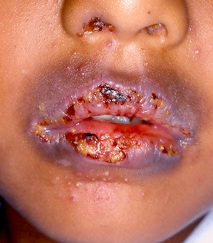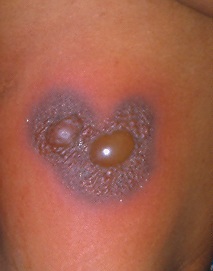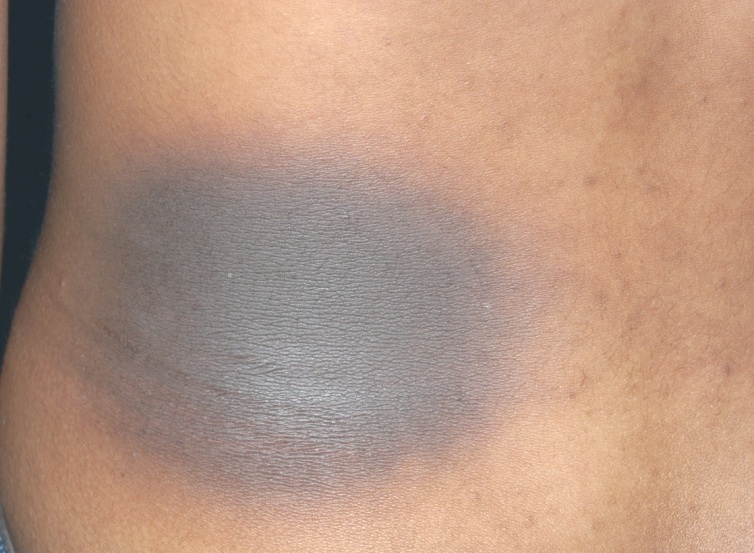Fixed drug eruption (FDE) is a common presentation of drug allergy. It usually appears abruptly (acute) within 30 minutes to 8 hours after taking a specific medication. Upon re-exposure to the causative medication, it will cause recurrence at the same sites and resolve spontaneously after a few days with residual hyperpigmentation.
Signs & Symptoms
The skin lesion in fixed drug eruption can be single or multiple. It can be itchy or present with a burning sensation. Each lesion has a well-circumscribed border, round or oval in shape and the colour is red or violaceous (puplish). It can progress in size up to 10 cm or become oedematous (swollen) with blisters. The skin lesions can appear on the abdomen, arms and legs, palms and soles, lips, oral mucosa and genitalia.
 |
| Figure 1: There is a violaceous skin lesion with lip erosions |
 |
 |
| Figure 2: The reddish violaceous FDE has formed blisters | Figure 3: Residual hyperpigmentation |
Common causes of Fixed Drug Eruption
Fixed drug eruption is commonly due to oral medications. There have been reports due to Chinese herbal medicine. In up to 40 percent of cases, non-steroidal anti-inflammatory drugs (painkillers) were implicated. They include ibuprofen, indomethacin and piroxicam. The common antibiotics involved are amoxicillin, trimethoprim/sulfamethoxazole, tetracyclines, ofloxacin and dapsone. Fixed-drug eruptions have also been associated with paracetamol, phenolphthalein, sulfonamides, phenylbutazone, barbiturates, and salicylates.
When to suspect drug allergy
These lesions are most commonly seen after oral medication intake. Classically, FDE occurs 1 to 2 weeks after initial exposure to a specific medication. It may also occur a few weeks to several years after a person starts taking a particular medication. Once the patient has become allergic to a specific medication, on average it may appear abruptly approximately 2 hours later. There can be a delay of up to 48 hours.
The unique appearance of FDE is quite easily distinguishable. A person taking multiple types of medications should be suspected as having drug allergy if the skin lesions appear abruptly.
Although oral re-challenge with the suspected drug is the best way to confirm the diagnosis, it can be risky to the patient. In some patients the skin lesions can be quite large with multiple blisters and therefore not acceptable to them.
Treatment
The most important treatment is to stop the offending medication. Your doctor need to assist you to determine which medication is causing the problem. This can be done based on the doctors knowledge of the more common medications that can cause FDE.
In the presence of blisters, the nurse or doctor can help to remove the fluid. Antihistamines and topical steroid can be used. However, topical steroid can only be applied if there are no more blisters. Sometimes oral steroids are given to patients with severe reactions.
Prevention
Avoidance of the implicated medication is important to avoid recurrence. Patients should carry their drug allergy card that is given by the doctor. Sometimes patients can wear a bracelet or necklace with the name of the medication engraved (medic alert).
Always inform your doctor that you have a drug allergy and show your allergy card whenever you see a doctor for treatment.
For those interested to make an engraved bracelet or necklace, please visit this website: http://www.medicalert.com.my
| Last Reviewed | : | 23 August 2019 |
| Writer | : | Datin Dr. Asmah bt. Johar |
| Accreditor | : | Datuk Dr. Roshidah bt. Baba |
| Reviewer | : | Dr. Nazatul Shima bt. Abd Rahim |







